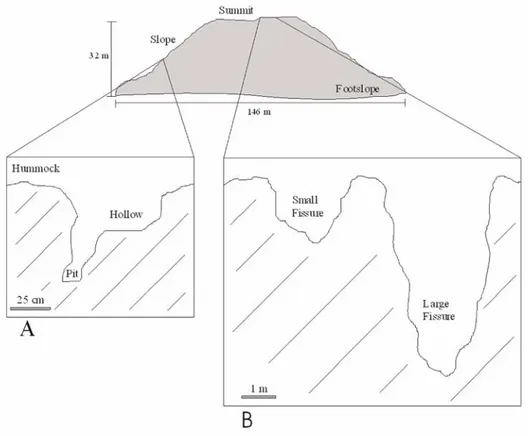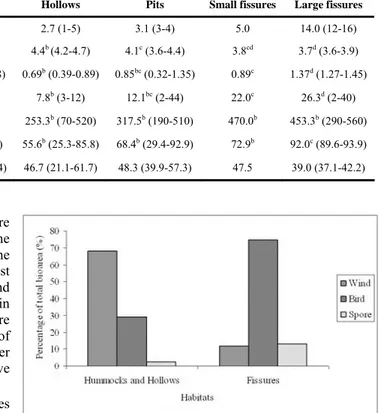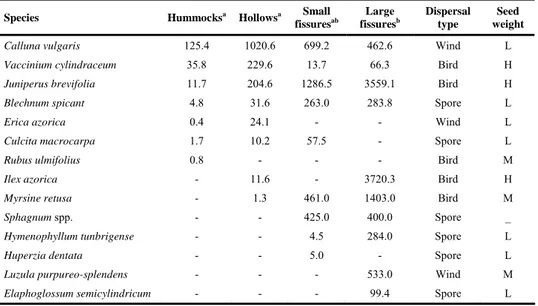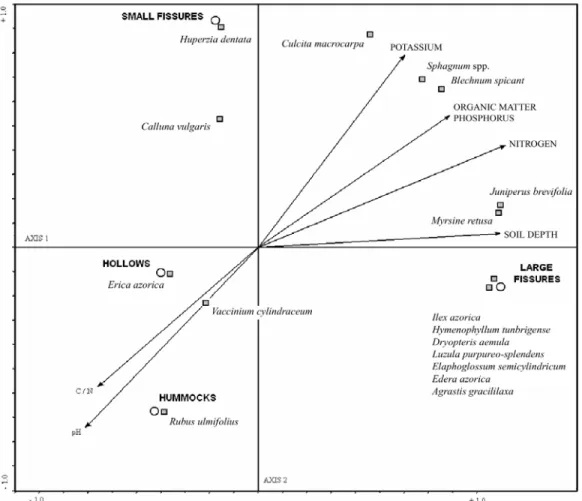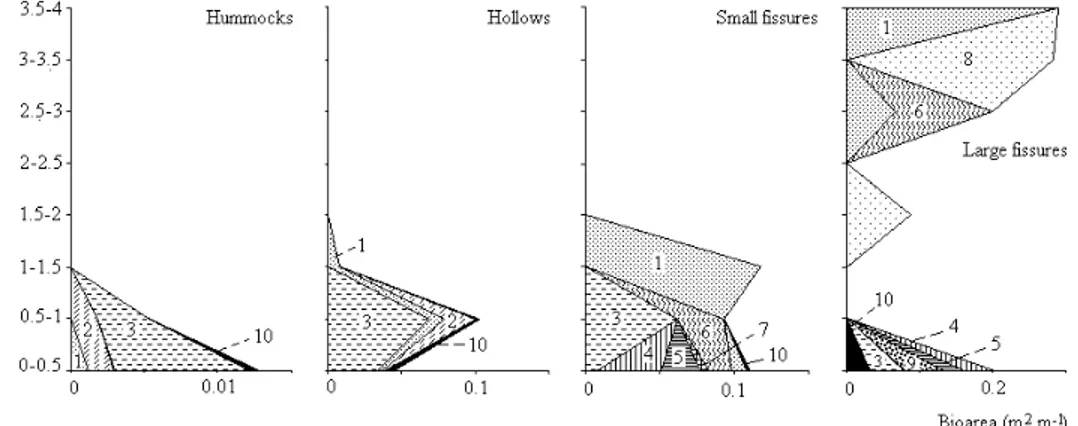The role of habitat features in a primary succession
RUI B.ELIAS &EDUARDO DIASElias, R.B. & E. Dias 2007. The role of habitat features in a primary succession. Arquipélago. Life and Marine Sciences 24: 1-10.
In order to determine the role of habitat features in a primary succession on lava domes of Terceira Island (Azores) we addressed the following questions: (1) Is the rate of cover development related to environmental stress? (2) Do succession rates differ as a result of habitat differences? One transect, intercepting several habitats types (rocky hummocks, hollows and pits, small and large fissures), was established from the slope to the summit of a 247 yr old dome. Data on floristic composition, vegetation bioarea, structure, demography and soil nutrients were collected. Quantitative and qualitative similarities among habitats were also analyzed. Cover development and species accumulation are mainly dependent on habitat features. Habitat features play a critical role in determining the rate of succession by providing different environmental conditions that enable different rates of colonization and cover development. Since the slope’s surface is composed of hummocks, hollows and pits the low succession rates in these habitats are responsible for the lower rates of succession in this geomorphologic unit, whereas the presence of fissures in the dome’s summit accelerates its succession rate.
Key words: Azores, Calluna vulgaris, cover development, dispersion, Juniperus brevifolia
Rui B. Elias (elias@uac.pt) & Eduardo Dias, Centro de Estudos do Clima, Meteorologia e Mudanças Globais, Departamento de Ciências Agrárias, Universidade dos Açores, Terra Chã, PT-9701-851 Angra do Heroísmo, Açores, Portugal.
INTRODUCTION
How vegetation recovers from disturbance is a central ecological question, and the understanding of how volcanic landscapes recover informs us about fundamental ecological processes. Studies of primary succession are important despite the relatively small areas that are now undergoing this process, largely confined to sand dunes, recent volcanic deposits, receding glaciers, river point bars, land slides, some anthropogenic sites and a few other sources of new soil (Aplet et al. 1998; Dlugosch & del Moral 1999; Marchese & Grillo 2000; Mueller-Dombois 2000; Kamijo et al. 2002; Walker & del Moral 2003).
The rates of primary succession can differ significantly among sites and in different climatic regimes, but as conditions are ameliorated by weathering and nutrient
2007). Sites that lack the conditions for microclimatic and substrate amelioration are not opportune places for a plant to grow (Titus & del Moral 1998). In fact, succession stages may relate primarily to habitat differences related to the lava substrate. Of particular importance are the surface morphology and soil depth as well as the microclimatic conditions (Tagawa et al. 1985; Marchese & Grillo 2000). The rate of plant cover development may be related to environmental stress while the rate of species accumulation may depend on the degree of isolation (del Moral & Bliss 1993). Early colonization of isolated sites may be stochastic and dispersal may affect species composition more strongly than environmental factors or competitive interactions (del Moral 1999).
In a previous work (Elias & Dias 2004) we have demonstrated that the primary succession on
complexity. It was possible to see examples of late succession forests on large fissures, in the summit of young domes. It was also demonstrated that the succession rates were quite different among the geomorphologic units (footslopes, slopes and summits) of the domes, resulting in different stages being simultaneously present on the dome. As a result we proposed the hypothesis that the observed differences were determined by habitat features that influenced the establishment of species and the rate of cover development during the colonization and early succession stages. Our goal is to clarify how habitat heterogeneity influences the primary succession on lava domes. For that purpose we will address the following questions: (1) Is the rate of cover development related to environmental stress? (2) Do succession rates differ as a result of habitat differences?
MATERIAL AND METHODS
STUDY AREA
Terceira Island is located in the central group of Azorean Islands, it has an area of 382 km2 and the highest mountain is the Santa Bárbara volcano with 1023 m a.s.l. The study area is located on the western part of Terceira Island, on the eastern slope of the Santa Bárbara volcano (38º44’N; 27º17’W). After the formation of the caldera, this volcano experienced the emission of several trachyte domes and coulées both inside and on the western and eastern slopes of the caldera, in the last 15000 years. Subsequent deposits of pumice covered some of these domes until 2080 years ago. The formation of trachyte domes and coulées occurred, in a non continuous manner, until 1761 A.D. when the dome called «Mistérios Negros» was formed (Zbyszewski et al. 1971; Self 1976; Dias et al. 2004). This dome (situated at 630 m a.s.l.) was the object of the present study.
The climate is temperate maritime with a high level of humidity and rainfall which is both regular and well distributed throughout the year. The annual precipitation is 4.109 l/m2 (at 600 m of altitude) and the average annual temperature is
15ºC. The study area is part of the NATURA 2000 Site of Community Importance of Santa Bárbara-Pico Alto and has an important set of endemic vegetation, dominated by Juniperus forests and succession vegetation (Dias et al. 2004).
DOME SURFACE MORPHOLOGY
Lava (trachyte) domes result from the accumulation of viscous peralkaline salic lavas around a fissure. As a result these geologic forms are round or oval, lack a crater and have very steep slopes (Self 1976). Lava domes are composed of three geomorphologic units: footslope (near the undisturbed vegetation), slope (the steep lateral slopes of the dome) and summit (the upper part of the dome). The most recent dome (object of the present study), formed 247 years ago (Neves 1826; Drummond 1836), presents clear differences between geomorphologic units due to different succession rates. The decrease of the succession rates is reflected in the decrease in vegetation cover and structural complexity from footslope, to summit, to slope (Elias & Dias 2004). This means that, in terms of succession, the slope of the dome is less developed than the summit, and these two geomorphologic units are less developed than the footslope. Since the vegetation of the footslope is well developed and has high similarity with the surrounding vegetation it was not sampled for this study.
The surface morphology of a dome is very irregular, with the presence of hummocks, hollows and pits, on both the slope and summit (Fig. 1). These habitats are present in the lateral slopes and summit of the dome. The summit also includes small and large fissures that are a consequence of the eruption’s final events. As the lava supply exhausted, large fissures developed parallel to the dome perimeter, as the central part drained out and collapsed. As the lava cools contraction cracks (small fissures) also develop.
FIELD DATA COLLECTION
One 80 m long line intercept transect, was established from the slope to the summit of the
Fig. 1. Geomorphology of a lava dome showing two details of the surface (A and B) with the five habitat types identified: hummock, hollow, pit, small and large fissures.
dome. The method was adapted from the transect method described by Mueller-Dombois & Ellenberg (1974). Along the transect several habitat types were intercepted, each occupying different lengths: hummocks - 38 m; hollows - 29 m; pits - 4 m; small fissures - 4 m; large fissures - 5 m. Canopy height and length, along the intercept, were measured for each individual plant. Habitat type was also recorded. In the case of grasses, small ferns, and macro bryophytes, only the height and length were measured. Algae, lichens and bryophytes were not sampled with the exceptions of Sphagnum spp. and Polytrichum commune. Nomenclature is in accordance with Rivas-Martínez et al. (2002). A profile of the dome, with each individual plant in its exact
DATA ANALYSIS
The collected data were separated by habitat type and the species bioarea was calculated. Previous studies showed that the best approach for the study of Azorean natural vegetation was the use of the biovolume and bioarea (Dias 1996; Elias & Dias 2004). Assuming that the shape of the canopies (in lateral view) is similar to an ellipse, it is possible to calculate the area occupied by the canopies along the transect (giving the trunk a symbolic bioarea value).
Thus the absolute bioarea (BAa) (m2) of a given individual plant is given by (1):
the canopy intercept length and CH is the canopy height. For grasses, small ferns and macro bryophytes the absolute bioarea (m2) is given by (2):
BAa = L × H (2)
where, BAa is the absolute bioarea occupied by the individual (or set of individual plants), L is its length intercept and H is its height. In this case the shape of the individual plants in lateral view was considered similar to a rectangle.
The bioarea of a given species is the result of the sum of the bioareas of each individual plant. The relative bioarea (BAr) (m2.m-1) of a given species results from the division of its absolute bioarea (BAa) by the number of meters of the transect (M) (3):
BAr = BAa/M (3)
The vertical structure of the vegetation in each habitat type was analyzed through the height distribution of the bioarea by computing the area occupied by each species in regular height classes (using 0.5 m intervals) (see Elias & Dias 2004). The soil samples were analyzed by the Soil Laboratory of the Agrarian Sciences Department of the Azores University, in order to determine its content in organic matter (%), total nitrogen (%), phosphorus (ppm), and potassium (ppm) as well as pH and carbon-nitrogen ratio (C:N). Content in organic matter was determined by the lost of weight by calcination method (Blackmore et al. 1981). Total nitrogen was obtained by the Kjeldahl method (Bremner 1960). Phosphorus and potassium contents were determined by the methods described by Olsen et al. (1954) and Mehlich (1953), respectively. The significance of the differences between average nitrogen, phosphorus, potassium, organic matter and relative bioarea values of the different habitats were evaluated by Kruskal-Wallis tests followed by multiple comparison of ranks (Fernández-Palacios & Santos 1996; Zar 1996). Species diversity was evaluated through Shannon’s index (H’), using the species relative bioarea, instead of the number of individuals, and the natural logarithm (Magurran 1988). Qualitative similarity
between habitats was evaluated by the Community Coefficient (CC) as defined by Sorensen (1948) and modified by Bornkamm (1981). Quantitative similarity was determined by the Percent Similarity (PS) (Bornkamm 1981) but using relative bioarea instead of percent cover. Clearly, CC will be sensitive to changes in species presence/absence, whereas PS will indicate changes in relative bioarea relations. Analysis of associations between soil features and vegetation data was conducted through Redundancy Analysis (RDA) in order to depict relationships among habitats. The CANOCO 4.0 program package (ter Braak & Šmilauer 1998) was used to perform the analysis. Scaling was focused on inter-species correlations. Otherwise the default options were chosen. Bioarea data collected in a previous work, in a 2000 year old dome (Elias & Dias 2004) was used to analyze the similarity between mature vegetation and the vegetation of the different habitats in the early succession stage.
RESULTS
COVER DEVELOPMENT
With the exception of carbon-nitrogen ratio, all soil features differed significantly among habitat types (Table 1). P-values (according to the Kruskal-Wallis tests) for organic matter, total nitrogen, phosphorus, potassium, and pH were 0.005, 0.002, 0.03, 0.009 and 0.001, respectively. Soil was more developed in small and large fissures as these habitats had the highest soil depth, nitrogen, phosphorus, potassium and organic matter contents. Carbon-nitrogen ratio and pH had the lowest values, which indicate a higher degree of mineralization. The results demonstrated that soil related environmental stress was higher in hummocks and lower in_small and large fissures. Despite occupying an intermediate position, in terms of soil features, no vegetation (with the exception of algae and bryophytes) was found in pits. This fact may be related to substrate instability and low light. These habitats consist in deep narrow depressions in which the bottom is filled with small unstable rocks with little light.
Table 1. Values of the evaluated parameters in the soil analysis of each habitat (the range is indicated under brackets). Values in a line followed by the same letter are not significantly different (multiple comparison of ranks: P > 0.05).
Parameters Hummocks Hollows Pits Small fissures Large fissures
Soil depth (cm) 1.1 (1-2) 2.7 (1-5) 3.1 (3-4) 5.0 14.0 (12-16) pH 5.2a (4.9-5.7) 4.4b (4.2-4.7) 4.1c (3.6-4.4) 3.8cd 3.7d (3.6-3.9) Nitrogen (%) 0.18a (0.04-0.38) 0.69b (0.39-0.89) 0.85bc (0.32-1.35) 0.89c 1.37d (1.27-1.45) Phosphorus (ppm) 3.2a (2-5) 7.8b (3-12) 12.1bc (2-44) 22.0c 26.3d (2-40) Potassium (ppm) 62.0a (10-190) 253.3b (70-520) 317.5b (190-510) 470.0b 453.3b (290-560) Organic Matter (%) 16.3a (6.3-36.3) 55.6b (25.3-85.8) 68.4b (29.4-92.9) 72.9b 92.0c (89.6-93.9) C : N 81.0 (26.1-249.4) 46.7 (21.1-61.7) 48.3 (39.9-57.3) 47.5 39.0 (37.1-42.2)
Hummocks and hollows were present throughout the dome surface, occupying 84 % of the transect length, but had their highest expression in the slope. Small and large fissures were present only in the summit but, despite being more isolated and occupying only 11 % of the transect length, they had greater species richness, density, relative bioarea and diversity (Table 2). The values of these measures decreased in the hollows and hummocks. Species relative bioarea was significantly different among habitats (P = 0.038; Kruskal-Wallis
test) however, between hummocks and hollows the differences were not significant. Small fissures occupy an intermediate position between hollows and large fissures (Table 3). Vegetation in hummocks and hollows was dominated by Calluna vulgaris, Vaccinium cylindraceum and Juniperus brevifolia. Juniperus brevifolia clearly dominates in small fissures and, together with Ilex azorica, large fissures. Wind-dispersed species dominated in hummocks and hollows but in fissures most of the total bioarea was composed by bird-dispersed species and the importance of spore-dispersed species also increased (Fig. 2).
SUCCESSION RATES
(axis 1), which explained 94.3% of the variance in the data (Fig. 3). This axis was strongly correlated with soil depth, nitrogen, phosphorus and organic matter, and negatively correlated with soil pH and carbon-nitrogen ratio. Large fissures appeared at the positive extreme, associated with deep, fertile, and more acidic soils, with a high bioarea of Juniperus brevifolia and Ilex azorica, and the presence of other late succession species like Laurus azorica, Culcita macrocarpa, and Elaphoglossum semicylindricum. Hummocks and hollows appeared on the other side of axis 1, characterized by the more alkaline, shallow, and nutrient-poor soils, dominated by typical colonizing species Fig. 2. Percentage of total bioarea occupied by wind, bird and spore-dispersed species in hummocks/hollows and fissures.
Table 2. Species richness, density, absolute and relative bioarea and diversity in different habitats. The percentage of the transect length occupied by each habitat type is also indicated.
Vegetation structure was in accordance with the RDA analysis since the structure complexity increased from hummocks to large fissures (Fig. 4). In the hummocks the vegetation was composed of one shrub layer dominated by Calluna vulgaris, reaching 1 m height. Vegetation in the hollows was very similar, but reached 1.5 m height. In small fissures the vegetation presented one low herbaceous/bryophyte__layer dominated by Sphagnum spp.
Table 3. Species relative bioarea (cm2.m-1) in the different habitats (in large fissures only the 10 most
abundant species are showed). Dispersal type and seed weight (L = Light; M = Medium; H = Heavy) are also indicated. Habitats with the same letter are not significantly different (multiple comparison of ranks: P > 0.05) in species bioarea.
Species Hummocksa Hollowsa Small fissuresab Large fissuresb Dispersal type Seed weight
Calluna vulgaris 125.4 1020.6 699.2 462.6 Wind L
Vaccinium cylindraceum 35.8 229.6 13.7 66.3 Bird H
Juniperus brevifolia 11.7 204.6 1286.5 3559.1 Bird H
Blechnum spicant 4.8 31.6 263.0 283.8 Spore L
Erica azorica 0.4 24.1 - - Wind L
Culcita macrocarpa 1.7 10.2 57.5 - Spore L
Rubus ulmifolius 0.8 - - - Bird M
Ilex azorica - 11.6 - 3720.3 Bird H
Myrsine retusa - 1.3 461.0 1403.0 Bird M
Sphagnum spp. - - 425.0 400.0 Spore _
Hymenophyllum tunbrigense - - 4.5 284.0 Spore L
Huperzia dentata - - 5.0 - Spore L
Luzula purpureo-splendens - - - 533.0 Wind M
Elaphoglossum semicylindricum - - - 99.4 Spore L
and Blechnum spicant, one intermediate and poorly developed shrub layer of Calluna vulgaris and Myrsine retusa, and a high shrub layer of Juniperus brevifolia reaching 1.5 m height. Vegetation in large fissures had a clearly distinct and more developed structure with one shrub/low herbaceous/bryophyte layer dominated by Calluna vulgaris and Luzula purpureo-splendens, a high
shrub layer of Ilex azorica at the 1.5-2 m interval, and a canopy layer, reaching 4 m height, dominated by Juniperus brevifolia and Ilex azorica. An epiphytic layer of Hymenophyllum tunbrigense was present in the small fissures. This species together with Elaphoglossum semicylindricum formed the epiphytic layer in large fissures.
Parameters Hummocks Hollows Small
fissures Large fissures Species richness 7 8 9 16 Density (Nºind.m-1) 1.18 2.41 6.25 11.20 Absolute bioarea (m2) 0.69 4.45 1.29 5.45 Relative bioarea (m2.m-1) 0.02 0.15 0.32 1.09 Diversity (H’) 0.93 1.05 1.56 1.75 % of transect 47.50 36.30 5.00 6.30
Fig. 3. Species and habitats ordination obtained with Redundancy Analysis, RDA.
The similarity in species composition, as given by the Community Coefficient, was higher than 0.5 among all habitats, reaching the maximum
between hummocks and hollows, and the minimum between large fissures and hummocks (Table 4).
Table 4. Community Coefficient (CC – lower left corner) and Percent Similarity (PS – upper right corner) among the different habitats and mature vegetation.
CC \ PS Hummocks Hollows Small fissures Large fissures Mature vegetation
Hummocks __ 21.00 9.30 3.25 2.10
Hollows 0.80 __ 40.50 12.70 7.17
Small fissures 0.63 0.71 __ 41.50 25.00
The similarity between hummock vegetation and mature vegetation was low. However, when we compare small fissures and, especially, large fissures with mature vegetation the similarity in species composition was quite high. The similarity in bioarea, as given by the Percent Similarity, was low between hummocks and the
other habitats, reaching the maximum between small fissures-hollows and small fissures-large fissures. Although hummocks, hollows and small fissures have low similarities in bioarea with mature vegetation, the same did not happen with large fissures that presented a 57 % similarity, in spite_of_the_important_age_differences.
Fig. 4. Vegetation structure in each habitat type: 1- Juniperus brevifolia; 2- Vaccinium cylindraceum; 3- Calluna vulgaris; 4- Sphagnum spp.; 5- Blechnum spicant; 6- Myrsine retusa; 7- Culcita macrocarpa; 8- Ilex azorica; 9- Luzula purpureo-splendens; 10- Other species.
DISCUSSION
COVER DEVELOPMENT
The rates of cover development and species accumulation seem to be related to environmental stress. In fact, the development of both features was consistent with the improvement in the soil conditions. Fissures presented the higher number of species, bioarea and structural complexity, in spite of being more distant from the sources of colonists. As was stressed by other authors (Mueller-Dombois 1987; Wood & del Moral 1987; Mancebo 1991; Tsuyuzaki 1991; del Moral & Wood 1993; Mazzoleni & Ricciardi 1993) physical amelioration must occur before colonization can commence. Some habitats become more favourable due to erosion, weathering and nutrient inputs via wind and rain. In small and large fissures, soil formation is enhanced and drought stress is significantly reduced. In hummocks there is little microclimatic and substrate amelioration due to
chronic erosion and soil surface drought, and limited soil nutrients.
Previous studies showed that isolation and differential dispersal ability may combine to determine initial vegetation structure (del Moral & Wood 1993; del Moral 1998). Even minor isolation (< 100 m) can affect composition and limit succession rates (del Moral 1999). Fuller & del Moral (2003) demonstrated that, on Mount St. Helens, the proportion of the vegetation represented by wind-dispersed species increased with distance from refugia. Our results show a different pattern since the proportion of vegetation represented by wind-dispersed species decreases with distance from undisturbed vegetation. This is probably due to the presence of fissures on the dome’s summit. In fact, fissures are dominated by bird dispersed species and are the more isolated habitats. These are favourable habitats where wind dispersed colonizing species like Calluna vulgaris and Erica azorica may have colonized early on but have been competitively
displaced by larger bird-dispersed species like Juniperus brevifolia and Ilex azorica.
The results show that many species present in mature forests are capable of colonizing recent substrates. This is especially evident with Juniperus brevifolia and Vaccinium cylindraceum. Juniperus brevifolia is an important colonizer and, at the same time, the dominant species in mature forests. Vaccinium cylindraceum is also an important colonizing species but maintains it self throughout the succession (Elias & Dias 2004). Even the typical mature species Ilex azorica is present in large fissures, where conditions are more favourable. In fact, in these habitats the similarity, in species composition, with mature vegetation is high. The only true colonizing vascular species are Calluna vulgaris and Erica azorica.
The results demonstrate that isolation does not play an important role in the primary succession at this site. Cover development and species accumulation are mainly dependent on habitat features. Since this site is already 247 years old there has been some time for chance dispersal events to occur. More importantly, the effects of isolation may be overcome by the ability of some species to colonize recent substrates especially those with more favourable conditions. The Azores have only ca. 300 native species and some of them have large ecological amplitudes. Thus, chance dispersal, the small number of typical pioneer species and the large ecological amplitude of several species may explain these results.
SUCCESSION RATES
Habitat features play a critical role in determining the rate of succession by providing different environmental conditions that enable different rates of colonization and cover development. Succession rates are dependent on the rates of plant colonization, secondary dispersion and soil formation (Marchese & Grillo 2000). In large fissures succession rates are higher as a result of higher colonization and secondary dispersion rates, and better conditions for soil formation, whereas in hummocks environmental stress and lower colonization and secondary dispersal rates
presents clear differences between geomorphologic units as a result of different succession rates among those units. The footslope is at a much more advanced succession stage, due to its proximity to the undisturbed vegetation and lower stress. The slope of the dome is in a very early succession stage and the summit is in an intermediate position (Elias & Dias 2004). Since the slope’s surface is composed of hummocks, hollows and pits the low succession rates in these habitats are responsible for the lower rates of succession in the geomorphologic unit, whereas the presence of fissures in the dome’s summit accelerates its succession rate.
ACKNOWLEDGEMENTS
We would like to thank José Madeira, Fernando Pereira and Lurdes Matos. This study was supported by the Project LIFE96NAT-P-3022 «Study and conservation of Azorean natural patrimony», from the Agrarian Sciences Department of the Azores University and Forestry Resources Secretariat of the Azores Regional Government.
REFERENCES
Aplet, G.H., R.F. Hughes & P.M. Vitousek 1998. Ecosystem development on Hawaiian lava flows: biomass and species composition. Journal of
Vegetation Science 9: 17-26.
Blackmore, L.C., P.L. Searle & B.K. Daly 1981. Soil bureau laboratory methods: A. Methods for chemical analysis of soils. New Zealand Soil
Bureau Scientific Report 10A [revised].
Bremner, J.M. 1960. Determination of nitrogen in soil by the Kjeldahl method. Journal of Agricultural
Science 55: 11-33.
Bornkamm, R. 1981. Rates of change in vegetation during secondary succession. Vegetatio 47: 213-220.
del Moral, R. 1998. Early succession on lahars spawned by Mount St. Helens. American Journal
of Botany 85(6): 820-828.
del Moral, R. 1999. Plant succession on pumice at Mount St. Helens, Washington. American Midland
Naturalist 141: 101-114.
primary succession: insights resulting from the eruption of Mount St. Helens. Advances in
Ecological Research 24: 1-66.
del Moral, R. & D.M. Wood 1993. Early primary succession on the volcano Mount St. Helens.
Journal of Vegetation Science 4: 223-234.
del Moral, R. & E.E. Ellis. 2004. Gradients in heterogeneity and structure on lahars, Mount St. Helens, Washington, USA. Plant Ecology 175: 273-286.
Dias, E. 1996. Vegetação natural dos Açores. Ecologia
e sintaxonomia das florestas naturais. PhD thesis.
Universidade dos Açores. Angra do Heroísmo, Azores.
Dias, E., R.B. Elias & V. Nunes. 2004. Vegetation mapping and nature conservation: a case study in Terceira Island (Azores). Biodiversity and
Conservation 13: 1519-1539.
Dlugosch, K. & R. del Moral 1999. Vegetational heterogeneity along elevation gradients. Northwest
Science 73: 12-18.
Drummond, F.F. 1836. Annaes da ilha Terceira. Câmara Municipal de Angra do Heroísmo. Angra do Heroísmo, Azores. 288-290 pp.
Elias, R.B. & E. Dias 2004. Primary succession on lava domes on Terceira (Azores). Journal of Vegetation
Science 15: 331-338.
Fernández-Palacios, J.M. & A. Santos 1996. Ecologia
de las islas Canarias - Muestreo y análisis de po-blaciones y comunidades. Sociedad La
Cosmo-lógica, Santa Cruz de La Palma, Canarias.
Fuller, R.N. & R. del Moral 2003. The role of refugia and dispersal in primary succession on Mount St. Helens, Washington. Journal of Vegetation Science 14: 637-644.
Kamijo, T., K. Kitayama, A. Sugawara, S. Urushimichi & K. Sasai 2002. Primary succession on the warm-temperate broad leave forest on a volcanic island, Miyake-Jima, Japan. Folia Geobotanica 37: 71-91. Magurran, A.E. 1988. Ecological diversity and its
measurement. Chapman and Hall, London. 179 pp.
Mancebo, J.M.G. 1991. Flora de las coladas
volcanicas historicas de las islas Canarias. Aproximacional estudio de la colonizacion y sucesion vegetal. PhD thesis. Departamento de
Biologia Vegetal. Universidad de La Laguna. Tenerife, Canarias.
Marchese, E.P. & M. Grillo 2000. Vegetation dynamics on lava flows on Mt. Etna. Pp. 210-213 in:
Proceedings IAVS Symposium.
Mazzoleni, S. & M. Ricciardi 1993. Primary succession on the cone of Vesuvius. Pp. 101- 112 in: Miles, J. & D.W.H. Walton (Eds), Primary
sucession on land. Blackwell Scientific
Publications, Oxford.
Mehlich, A. 1953. Determination of P, Cu, Mg, K, Na
and NH4. North Carolina Soil Test Division.
Raleigh. N.C.
Mueller-Dombois, D. 1987. Forest dynamics in Hawaii. Tree 2(7): 216-219.
Mueller-Dombois, D. 2000. Succession and zonation in the Hawaiian Islands. Pp. 203-206 in: Proceedings
IAVS Symposium.
Mueller-Dombois, D. & H. Ellenberg 1974. Aims and
methods of vegetation ecology. John Wiley & Sons,
London. 547 pp.
Neves, J.A. 1826. Entretenimentos cosmológicos,
geográficos e históricos, Tomo I. Impressão Regia,
Lisbon. 247-252 pp.
Olsen, S.R., C.V. Cole, F.S. Watanable & L.A. Dean 1954. U.S.Department of Agriculture Circular, no. 939.
Rivas-Martínez, S., T. Díaz, F. Fernández-González, J. Izco, J. Loidi, M. Lousã & A. Penas 2002. Vascular plant communities of Spain and Portugal. Addenda to the syntaxonomical checklist of 2001. Part II.
Itinera Geobotanica 15(2): 433-922.
Self, S. 1976. The recent volcanology of Terceira, Azores. Journal of the Geological Society of
London 132: 645-666.
Tagawa, H., E. Suzuki, T. Partomihardjo & A. Suriadarma 1985. Vegetation and succession on the Krakatau Islands, Indonesia. Vegetatio 60: 131-145.
ter Braak, C.J.F. & Šmilauer P. 1998. CANOCO
Reference manual and user’s guide to Canoco for Windows. Software for canonical community ordination (version 4.0). Centre for Biometry,
Wageningen. 351 pp.
Titus, J.H. & R. del Moral 1998. Seedling establishment in different microsites on Mount St. Helens, Washington, USA. Plant Ecology 134: 13-26.
Tsuyuzaki, S. 1991. Species turnover and diversity during early stages of vegetation recovery on the volcano Usu, northern Japan. Journal of Vegetation
Science 2: 301-306.
Walker, L.R. & R. del Moral 2003. Primary succession
and ecosystem rehabilitation. Cambridge
University Press, Cambridge. 442 pp.
Wood, D.M. & R. del Moral 1987. Mechanisms of early primary succession in subalpine habitats on Mount St. Helens. Ecology 68: 780-790.
Zar, J. 1996. Biostatiscal analysis (3rd edition). Prentice Hall, New Jersey. 662 pp.
Zbyszewski, G., A.C. Medeiros, O.V. Ferreira & C.T. Assunção 1971. Carta geológica de Portugal.
Notícia explicativa da folha ilha Terceira. Serviços
Geológicos de Portugal, Lisboa.
